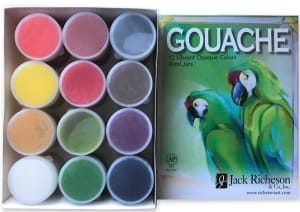How to Use Gouache
Recently, gouache paints have been experiencing a renaissance. The velvety, versatile nature of gouache (rhymes with squash) attracts beginners and experienced painters alike. So if you've ever wondered what it is or how to paint with gouache, keep reading!
Intro to Gouache
Nontoxic and water-based, gouache is often touted as ideal for novice painters because it’s easy to rework and less expensive than oil paints. However, gouache has its own challenges, and may or may not be suitable for a beginner.
Gouache paints date back to the ancient Egyptians, who mixed pigments with honey or other binders. Famous artists who have used the medium include Albrecht Durer, Paul Klee, Salvador Dalí, Edgar Degas, and even Jackson Pollock.
We can’t talk gouache without mentioning Henri Matisse, who used the medium in his famous cut-out series. I’ve always loved Matisse’s bold, colorful flair, so as I prepared to delve into the world of gouache, I found myself drawn to vibrant colors and lines that echo his style.
Dabbling with Gouache
Until recently, gouache was the one medium I had never worked in. So, I decided to experiment with two small gallery-wrapped canvases I had on hand. I found a Gouache Jar Set from Jack Richeson & Co., purchasing it online at Jerry’s Artarama.

This gouache paint set includes: Zinc White, Yellow Light, Ochre Light, Red Vermilion, Alizarin Crimson, Iron Oxide, Prussian Blue, Emerald Light, Violet Deep, Green Deep, Mars Brown, and Carbon Black.

Prussian Blue mixed with Zinc White.
The colors are gorgeous — deep and rich — although I recommend you pick up an extra container of Zinc White for tinting if you prefer colors that aren’t as high chroma. You can create lovely blacks and browns by combining two complementary colors. Complementary colors are two colors that, when placed side-by-side, create the strongest contrast; examples are red/green, yellow/violet, and blue/orange. Subtle neutrals can be achieved by adding Zinc White.

Mix two complementary colors to create shades of black and brown. Add Zinc White for softer neutrals.
The Challenges and Benefits of Painting with Gouache
Add water or build texture. Although I loved the creamy texture, my initial attempts to work with gouache came out quite flat-looking for my taste. I was able to solve this easily by adding a lot more water, which resulted in a fairly loose style for my “Still Life with Flowers and Fruit.” It’s equally a breeze to build the consistency of gouache paint. In my “Pineapple” painting, I bulked up the texture by applying multiple layers with a palette knife; no separate texture gel necessary. Although my cheaper synthetic bristle brushes worked fine for these paintings, natural bristle brushes might be more appropriate for glazing with gouache. The Creative Folk has a great blog on the five best brushes for gouache.

“Still Life With Flowers & Fruit” by Joely Rogers.

“Pineapple” by Joely Rogers.
Reworking and remixing. Gouache dries quickly, but it’s a breeze to rework. (I typically use watercolors and acrylics, so gouache’s rework-ability was a pleasant change for me.) Keep a small spray bottle handy to rewet your canvas or paper as needed. Also, I found that the gouache paint in the jar set separates easily, and needs to be remixed before using. Gouache is also available in pan sets and tubes.
Indoors or out. My gouache painting experiment took place in my studio. However, if you enjoy painting outdoors, gouache is a flexible medium for plein air studies done on paper. Below are three plein air gouache sketches on Strathmore Toned Tan Mixed Media paper. I created these using the Jack Richeson paint set. First, I placed an assortment of colors on a paper palette, then folded it in half, then rewet the gouache at my painting spot.

Plein air painter Michael Chesley Johnson has an excellent blog post discussing what’s in his plein air gouache kit along with some excellent “nuts and bolts” tips on plein air painting with gouache.
Matte or gloss. Gouache dries completely matte, but you can apply a gloss finishing varnish if you prefer more shine. I’ve been using the Krylon brand of aerosol varnishes and finishes for years. To add a little extra sheen to your gouache art, try their Satin Finish, or to keep the matte look while adding extra protection for your art, use the Matte Finish. If an aerosol varnish doesn’t work for you, Liquitex has excellent high gloss, gloss, and matte varnishes that can be applied with a brush.
Framing Gouache Paintings
When you’re ready to frame your own gouache paintings, we have an extensive collection of custom frames to complement your artwork. If you decide to use canvas, as I did, consider using a wood floater frame, which gives stretched canvases a professional, unique look. The edges of the painting remain uncovered, letting the artwork “float” within the frame. For details, read our article on why floater frames are one of our top-selling items. Check out our guide on framing canvas paintings for more ideas and tips.
My Final Thoughts
Overall, I enjoyed my first forays into using gouache, and I can see why these paints are experiencing a resurgence in popularity. Next, I might blend gouache with another medium like watercolor — à la Fidelia Bridges, one of my favorite female artists whose watercolor/gouache paintings feature sensitive depictions of local flora and fauna.
We’ll see what happens with a little practice and playing around!
Last Updated May 6, 2021